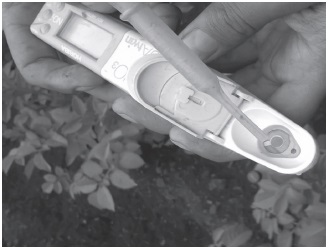Diagnostics of K+ and NO3- in sap to determine nutritional status in potato (Solanum tuberosum L. subsp. andigena)
DOI:
https://doi.org/10.17584/rcch.2017v11i1.6132Keywords:
Sap analysis, Nutrient indicators, Efficient use of K and NAbstract
Sap analysis is a nutritional diagnostic tool to provide timely fertilization adjustments in crops. The objective of this study was to determine the reference levels of NO3 - and K+ in sap per phenological stage. The study evaluated the proper use of this nutritional diagnostic tool for N and K in Diacol Capiro and Pastusa Suprema potato on the Bogotá Plateau at 55, 75, 100, 125 and 150 days after sowing (das) in response to balanced fertilizer levels (0; 1,450; 1,900 and 2,375 kg ha-1) on the yield, dry matter and harvest index to determine levels for cultivation and phenology. The highest K+ concentration in sap in the stems occurred at the vegetative stage with 4,800-5,000 mg L-1, decreasing in tuberization with 2,725 mg L-1, without significant differences between cultivars; contrary to the behavior of N-NO3 - in the stems, where the maximum concentration at tuberization was 2,466 mg L-1 Capiro and 2,200 mg L-1 Supreme, with decreased values at physiological maturity. The reference levels were obtained at flowering stage for Capiro by quadratic adjustment of N-NO3 - and K+ in sap with 3,280 mg L-1 and 1,231 mg L-1, respectively, and related with the response to fertilization, yield, dry matter, and leaf area. In contrast for Supreme, the evaluated N, with levels higher than 1,250 mg N-NO3 - L-1 in sap, supposed luxury consumption. Using this diagnostic tool in the field, adjustments can be made to the management of nitrogen and potassium nutrition of these cultivars.
JEL Classification
ArrayDownloads
References
Aguilera, J., P. Motavalli, M. Gonzales y C. Valdivia. 2014. Evaluation of a rapid field-test method for assessing nitrogen status in potato plant tissue in rural communities in the Bolivian Andean highlands. Comm. Soil Sci.
Plant Anal. 45, 347-361. Doi: 10.1080/00103624.2013.857680
Badillo-Tovar T., V., J.Z. Castellanos, P. Sánchez, A. Galvis, E. Álvarez, J.X. Uvalle, D. González y S.A. Enríquez.
Niveles de referencia de nitrógeno en tejido vegetal de papa var. Alpha. Agrocienc. nov-dic., 615-623.
Brink, P., P. Combrink y F. Knight. 2002. Evaluation of petiole nitrate measurement as an aid for N fertilization
of potatoes (Solanum tuberosum L.) on sandy soils. S. Afr. J. Plant Soil. 19, 1-7. Doi: 10.1080/02571862.2002.10634428
Carson, L., M. Ozores-Hampton y K. Morgan. 2016. Correlation of petiole sap nitrate-nitrogen concentration
measured by ion selective electrode, leaf tissue nitrogen concentration, and tomato yield in Florida. J. Plant Nutr. 39(12), 1809-1819. Doi: 10.1080/01904167.2016.1187743
Cadahía, C. 2008. La savia como índice de fertilización. Cultivos agroenergéticos, hortícolas, ornamentales y
frutales. Mundi-Prensa, Madrid, España.
De Jong, H. 2016. Impact of the potato on society. Amer. J. Potato Res. 93(5), 415-429. Doi: 10.1007/
s12230-016-9529-1
Errebhi, M., C. Rosen y D.E Birong. 1998. Calibration of a petiole sap nitrate test for irrigated ‘Russet Burbank’
potato. Comm Soil Sci. Plant Anal. 29 (1-2), 23-35. Doi: 10.1080/00103629809369926
Gangaiah, C., A. Ahmad, H. Nguyen y T. Radovich. 2016. A correlation of rapid Cardy meter sap test and ICP
spectrometry of dry tissue for measuring potassium (K+) concentrations in Pak Choi (Brassica rapa Chinensis
Group). Comm. Soil Sci. Plant Anal. 47 (17), 2046-2052. Doi: 10.1080/00103624.2016.1208752
Goffart, J.P., M. Olivier y M. Frankinet. 2008. Potato crop nitrogen status assessment to improve N fertilization
management and efficiency: Past–present–future. Potato Res. 51(3-4), 355-383. Doi: 10.1007/s11540-008-9118-x
Gómez, M.I. y P. Torres. 2012. Absorción, extracción y manejo nutricional del cultivo de papa. Rev. Papa (Fedepapa) 26(1), 20-25.
Hochmuth, G.J. 1994. Plant petiole sap-testing for vegetable crops. University of Florida Cooperative Extension
Service, Institute of Food and Agriculture Sciences, EDIS, Gainesville, FL, USA.
IDEAM. 2015. Reportes meteorológicos y climáticos estación Villa Inés 2012-2015. Instituto de Hidrología, Meteorología y Estudios Ambientales, Bogotá, Colombia.
Kelling, K.A., E. Panique, P.E. Speth y W. Stevenson. 2002. Effect of potassium rate, source and. application timing on potato yield and quality. Proc. Idaho Potato Conference.
Kolbe, H. y S. Stephan-Beckmann. 1997. Development, growth and chemical composition of the potato crop
(Solanum tuberosum L.). I. Leaf and stem. Potato Res. 40, 111-129. Doi: 10.1007/BF02407567
Kumar, C.V., S.S. Prakash, G.M. Prashantha, M.B. Mahendra Kumar, S. Lohith y T. Chikkaramappa. 2013. Dry
matter production and yield of potato as influenced by different sources and time of fertilizer application
and soil chemical properties under rained conditions. Res. J. Agric. Sci. 4(2), 155-159.
Lefèvre, I., J. Ziebel, C. Guignard, J.F. Hausman, R.O. Gutiérrez Rosales, M. Bonierbale, L. Hoffmann, R. Schafleitner y D. Evers. 2012. Drought impacts mineral contents in Andean potato cultivars. J. Agron. Crop Sci. 198(3), 196-206. Doi: 10.1111/j.1439-037X.2011.00499.x
Mäck, G., J. Schjoerring, 2002. Effect of NO3 - supply on metabolism of potato plants (Solanum tuberosum L.)
with special focus on the tubers. Plant Cell Environ. 25, 999-1009. Doi: 10.1046/j.1365-3040.2002.00892.x
Mohr, R.M. y D.J. Tomasiewicz. 2012. Effect of rate and timing of potassium chloride application on the yield
and quality of potato (Solanum tuberosum L. ‘Russet Burbank’). Can. J. Plant Sci. 92(4), 783-794. Doi:
4141/cjps2011-195
Moreira, M.A., P.C. Rezende, P.R. Cecon y R.F. Araújo. 2011. Seleção de índices para o diagnóstico do estado
de nitrogênio de batata-semente básica. Maringá. Acta Scient. Agron. 33(2), 335-340. Doi: 10.4025/actasciagron.
v33i2.5724
Moulin, A.P., Y. Cohen, V. Alchanatis, N. Tremblay y K. Volkmar. 2012. Yield response of potatoes to variable
nitrogen management by landform element and in relation to petiole nitrogen - A case study. Can. J. Plant
Sci. 92(1), 771-781. Doi: 10.4141/cjps2011-005
Pérez, J. 2015. Efecto de diferentes dosis de N y K sobre el rendimiento y fritura en papa (Solanum tuberosum L.) variedad pastusa suprema. Trabajo de grado. Facultad de Ciencias Agrarias, Universidad Nacional de Colombia, Bogotá, Colombia.
Rogozińska, I., E. Pawelzik, J. Poberezny y E. Delgado. 2005. The effect of different factors on the content of nitrate in some potato varieties. Potato Res. 48, 167-180. Doi: 10.1007/BF02742374
Rosen, C.J., M. Errebhi y W. Wang. 1996. Testing petiole sap for nitrate and potassium: A comparison of several
analytical procedures. HortScience 31(7), 1173-1176.
Ruza, A., I. Skrabule y A. Vaivode. 2013. Influence of nitrogen on potato productivity and nutrient use efficiency.
Proc. Latvian Acad. Sci. Sect. B. Natural Exact Appl. Sci. 67(3), 247-253.
Soil Survey Staff. 2010. Keys to soil taxonomy. 9th ed. United States Deparment of Agriculture (USDA), Soil
Conservation Service. Washington, USA.
Valbuena, R., G. Roveda, A. Bolaños, J. Zapata. C. Medina, P. Almanza y D. Porras. 2010. Escalas fenológicas de
las variedades de papa Parda Pastusa, Diacol Capiro y Criolla “Yema de Huevo” en las zonas productoras de
Cundinamarca, Boyacá, Nariño y Antioquia. Corpoica, Produmedios, Bogotá, Colombia.
Vitosh M.L., J.T. Ritchie, B. Basso y S. Stornaiuolo. 1998. Nitrate-N and nitrogen partitioning in potatoes under
different fertilizer management. Department of Crop and Soil Sciences, Michigan State University, East
Lansing, MI, USA. Doi: 10.1080/00103629609369622
Vitosh, M.L. y G.H. Silva. 1996. Factors affecting potato petiole sap nitrate tests. Comm. Soil Sci. Plant Anal.
(5-8), 1137-1152.
Waterer, D. 1997. Petiole sap NO3-N testing as a method for monitoring nitrogen nutrition of potato crops. Can. J. Plant Sci. 77(2), 273-278. Doi: 10.4141/P96-091
Ziadi, N., B. J. Zebarth, G. Bélanger y A.N. Cambouris, 2012. Soil and plant tests to optimize fertilizer nitrogen
management of potatoes. pp. 187-207. En: He, Z., R.P. Larkin y C.W. Honeycutt (eds). Sustainable potato
production: Global case studies. Springer, The Netherlands. Doi: 10.1007/978-94-007-4104-1_11

Downloads
Published
How to Cite
Issue
Section
License
The copyright of the articles and illustrations are the property of the Revista Colombiana de Ciencias Hortícolas. The editors authorize the use of the contents under the Creative Commons license Attribution-Noncommercial-ShareAlike 4.0 International (CC BY-NC-SA 4.0). The correct citation of the content must explicitly register the name of the journal, name (s) of the author (s), year, title of the article, volume, number, page of the article and DOI. Written permission is required from publishers to publish more than a short summary of the text or figures.
















